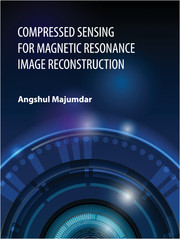Book contents
- Frontmatter
- Contents
- List of Figures
- List of Tables
- Foreword
- Preface
- Acknowledgements
- 1 Mathematical Techniques
- 2 Single Channel Static MR Image Reconstruction
- 3 Multi-Coil Parallel MRI Reconstruction
- 4 Dynamic MRI Reconstruction
- 5 Applications in Other Areas
- 6 Some Open Problems
- Index
- About the author
- Color Plates
4 - Dynamic MRI Reconstruction
Published online by Cambridge University Press: 05 June 2016
- Frontmatter
- Contents
- List of Figures
- List of Tables
- Foreword
- Preface
- Acknowledgements
- 1 Mathematical Techniques
- 2 Single Channel Static MR Image Reconstruction
- 3 Multi-Coil Parallel MRI Reconstruction
- 4 Dynamic MRI Reconstruction
- 5 Applications in Other Areas
- 6 Some Open Problems
- Index
- About the author
- Color Plates
Summary
So far we have been studying static MRI reconstruction. We were interested in the structure and anatomy of the cross section. In dynamic MRI, our interest is to study changing behavior – we study motion like blood flow, heartbeat, and changes in concentration like BOLD (blood oxygen level-dependent) signals. If we use a simile from digital photography – static MRI is a photo and dynamic MRI is a video.
The problems that fraught static MRI are pertinent here as well. We would like to accelerate dynamic MRI scans to the maximum possible extent. This is not only to reduce patient discomfort, but for technical reasons as well. Ideally, we would like to acquire a dynamic MRI video with high spatial and temporal resolution. However, we know that since the number of K-space samples that can be acquired in a unit of time is limited, there is always a trade-off between spatial and temporal resolution. Therefore, by traditional means we can get only high spatial resolution scans with low temporal resolution or vice versa. Such scans do not allow detection of fast events (owing to limitations in temporal resolution) or events concentrated in small areas (owing to limitations in spatial resolution).
In conventional dynamic MRI scans, the K-space for each frame is fully sampled. The frames are reconstructed by inverse Fourier transform. We have learnt in previous chapters that how Compressed Sensing (CS) has helped in accelerating static MRI scans. Similar techniques will be applicable here. We will learn all about them in detail later. But before going into the details, we will now briefly understand the two different types of dynamic MRI reconstruction modes.
There are broadly two classes of dynamic MRI reconstruction methods – offline and online. Offline methods reconstruct the images after all the data (pertaining to the all time frames) have been acquired. Online methods reconstruct the images for each time frame individually. They are causal, that is, the reconstruction of the current frame is only dependent on reconstructed previous frames. There is a special case of online reconstruction which is real time; here the images (corresponding to each time frame) are reconstructed as fast as they are acquired.
- Type
- Chapter
- Information
- Compressed Sensing for Magnetic Resonance Image Reconstruction , pp. 120 - 159Publisher: Cambridge University PressPrint publication year: 2015



